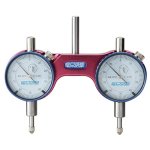CompositesGuy
Aluminum
- Joined
- May 30, 2009
- Location
- AZ
I got a couple of matching dial indicators off Ebay and finally got around to making a spindle tram tool. I used hardened 15-5ph stainless for the body, and an off-the-shelf hardened & ground 416 stainless pin for the shaft. Kept everything close tolerance and reamed the holes. As a final operation I cut the bottom flat surface parallel to the axis of shaft rotation, by mounting the assembled shaft/body in a collet on the lathe and taking a skim cut. The indicators were carefully set into the body (using feeler gauges between the dial and the body) at a height such that, when the tool is set onto a surface plate both needles point straight up to zero. The ground shaft is 0.75" diameter, because my 3/4" collet seems to live in my Bridgeport most of the time.
Reading some other threads about this type of tool I think that some have missed the fact that the tool can operate in two modes. I call them "coarse" and "fine". For the coarse mode you set the tool upright on a surface plate, and then zero both indicators. Then you put the tool into the mill and tilt the head until both indicators are in contact with the table and read the same value. I did this several times, and got the head to within 0.0005" of tram every time... much faster than I could with an Indicol and my Starrett Last Word. This method basically aligns the bottom of the tram tool to the table, but that is "coarse" because the shaft of the tool and R8 collet may be tilted within the spindle a little bit. In other words, even if the tool is made perfectly, the axis of the tram tool shaft may be slightly tilted from the true axis of spindle rotation thanks to tilt of the collet. That's ok though, because you still have "fine" mode. In this mode, you mount the tram tool in the mill, bring the tool into contact with the table, and zero the indicator on the left. Then you spin the tool 180 degrees about the spindle axis and zero the other indicator on the same spot on the table. Then you return the tool to is original position (back 180 degrees) and look at the needles. If both needles are on zero at that point, you are done. More likely, the first indicator will be zero and the other something like .0005". Then you just tilt the head until you split the difference (.00025) on both dials. Thus, "fine" mode removes the inaccuracy introduced by how carefully the tram tool was made, and also removes the aforementioned effect of the R8 collet tilting within the spindle.
(Note: In the picture, I touched the tool to the top of my vice jaws, which are not perfectly aligned to the table. Hence the slight difference between indicators).
Reading some other threads about this type of tool I think that some have missed the fact that the tool can operate in two modes. I call them "coarse" and "fine". For the coarse mode you set the tool upright on a surface plate, and then zero both indicators. Then you put the tool into the mill and tilt the head until both indicators are in contact with the table and read the same value. I did this several times, and got the head to within 0.0005" of tram every time... much faster than I could with an Indicol and my Starrett Last Word. This method basically aligns the bottom of the tram tool to the table, but that is "coarse" because the shaft of the tool and R8 collet may be tilted within the spindle a little bit. In other words, even if the tool is made perfectly, the axis of the tram tool shaft may be slightly tilted from the true axis of spindle rotation thanks to tilt of the collet. That's ok though, because you still have "fine" mode. In this mode, you mount the tram tool in the mill, bring the tool into contact with the table, and zero the indicator on the left. Then you spin the tool 180 degrees about the spindle axis and zero the other indicator on the same spot on the table. Then you return the tool to is original position (back 180 degrees) and look at the needles. If both needles are on zero at that point, you are done. More likely, the first indicator will be zero and the other something like .0005". Then you just tilt the head until you split the difference (.00025) on both dials. Thus, "fine" mode removes the inaccuracy introduced by how carefully the tram tool was made, and also removes the aforementioned effect of the R8 collet tilting within the spindle.
(Note: In the picture, I touched the tool to the top of my vice jaws, which are not perfectly aligned to the table. Hence the slight difference between indicators).
Attachments
Last edited:



